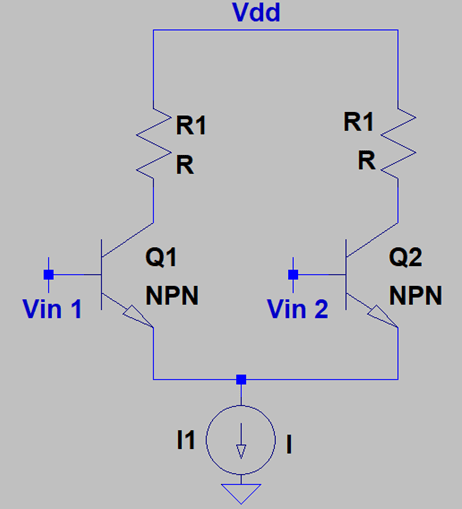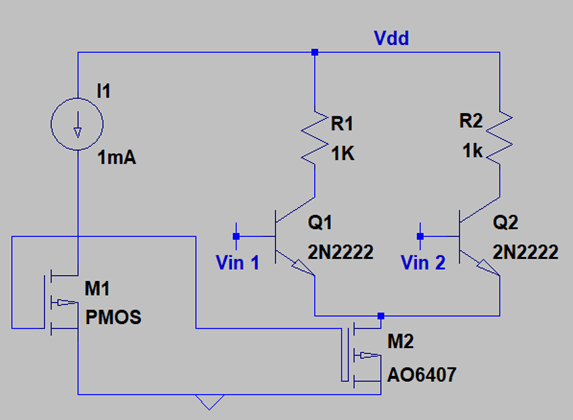This set of Microelectronics Multiple Choice Questions & Answers (MCQs) focuses on “Bipolar Differential Amplifiers”.
1. If Q1 & Q2 are identical, by what factor does the ratio of the differential output to the differential input change if the resistance connected to the collector terminal increases by a factor of 2? Ignore Early Effect.

a) 1.9856
b) 3.11
c) -5
d) -3/5
View Answer
Explanation: The ratio of the differential output to the differential input is regarded as the differential voltage gain. This voltage gain is similar to the voltage gain of a simple C.E. stage. Hence, the voltage gain would increase at least by a factor near to 2. It won’t definitely be much more than 2 and hence, the most plausible answer is 1.9856.
2. If the ratio of transconductance is equal to 2k:3k & k=6, what is the differential voltage gain? Ignore Early Effect. k is in mS.

a) 7*R
b) 8*R
c) 6*R
d) 9*R
View Answer
Explanation: If the two transconductances are not equal, this implies that the transistors are not identical. The differential voltage gain is 6*R.
3. If the emitter area of the transistor increases by a factor of 3, what should be the factor by which the doping concentration of the base is to be increased, such that the following differential amplifier provides the similar gain stage?

a) 1
b) 4
c) 2
d) 3
View Answer
Explanation: We note that the differential voltage gain is dependent on the transconductance, which in turn is proportional to the emitter area and inversely proportional to the doping concentration of the doping concentration of the base.
4. If the base width of the transistor increases by a factor of 3, what should be the factor by which the doping concentration of the base is to be changed, such that the following differential amplifier provides the similar gain stage?

a) 3.5
b) 3
c) 5
d) 2.5
View Answer
Explanation: The transconductance is proportional to the collector current which is inversely proportional to the product of the doping concentration and the width of the base. Hence, the doping concentration has to be decreased by a factor of 3 in the base.
5. If the collector current through each transistor is 1.08mA, what should be the collector resistance so that the magnitude of the differential voltage gain is 8?
a) 250 Ω
b) 300 Ω
c) 266.66 Ω
d) 260 Ω
View Answer
Explanation: The magnitude of the differential voltage gain is the product of the collector resistance and the transconductance of the device, which is .03S in this case. The collector resistance should be not less than 266.66Ω. Note that both the resistors & the transistors are assumed to be equal.
6. If the difference between the input of Q2 is greater than Q1, the collector current of Q1 is less than that of Q2.

a) True
b) False
View Answer
Explanation: With the emitter tied to a virtual ground, we note that if the input to transistor increases, the base-emitter voltage increases and inevitably, the collector current through that transistor increases while the collector current of the 2nd transistor decreases. Hence, the above statement is true.
7. For the virtual ground to exist at the emitter of each transistor, what is the characteristic of the current source?

a) Ideal
b) High output impedance
c) Low output impedance
d) Low gain
View Answer
Explanation: The current source tied at the bottom should be an ideal current source with infinite output impedance. It leads the path for a virtual ground at the emitter and the base-emitter voltage increases due to an increase in the base voltage.
8. If the difference between the input voltages of two transistors is 3 times the thermal voltage at 300K, what is the ratio of collector current of Q1 to Q2?

a) 20
b) 50
c) 70
d) -10
View Answer
Explanation: The drain current in Q1 to is the product of the exponential of ratio of different between the input voltages and thermal voltage and the drain current of Q2. Therefore, the ratio of collector current of Q1 is 20 times that of Q2.
9. What is the difference between the collector voltages of Q1 & Q2 if the difference between the input voltages is 3 times the thermal voltage and the collector resistance is 1kΩ. Note that the tail current source is 1mA.

a) .805V
b) .306V
c) .205V
d) .905V
View Answer
Explanation: The difference between the collector voltages is a product of the collector resistance, the tail current and tanh (Differential input voltage/Thermal voltage). We use the values provided and get the result as .905V.
10. The collector current through each transistor is equal if and only if ___________

a) the two transistors are identical
b) at least the emitter areas of two transistors are identical
c) the two transistors are identical and the tail current source is ideal
d) at least the emitter areas and the base width of two transistors are identical
View Answer
Explanation: The collector current is equal in two transistors if the two transistors are identical and their input voltages are equal. This also requires that the tail current be ideal so that the emitters are connected to a virtual ground.
11. If the MOSFETS are ideal (λ=0) and the aspect ratio of M2 is twice that of M1, find the difference in output voltage if the difference in input voltage is thrice the thermal voltage. Neglect Early Effect and both Q1 & Q2 are identical.

a) 3.526V
b) 2.956V
c) 2.705V
d) 2.715V
View Answer
Explanation: We note that M1 & M2 are behaving as a current mirror. Neglecting early effect and channel length modulation, we note that the tail current source is 3mA since the aspect ratio increases by a factor 3. Hence, the difference between the collector voltages of Q1 and Q2 is 2.715V. Note that this is an ideal case.
12. What is the ratio of the transconductances of M1 & M2, such that the tail current for the differential amplifier gives rise to a difference in collector voltage of about 1.91V between Q1 & Q2 if the difference in their input voltage is twice the thermal voltage? Assume that each transistor is ideal.

a) 2:1
b) 1:2
c) 1:4
d) 4:5
View Answer
Explanation: We note that the tail current required is approximately 2mA and this requires that the aspect ratio of M2 will have to be 4 times of M1. Note that the transconductance is proportional to the square root of the product of the aspect ratio and the drain current for a constant overdrive voltage. Hence, the ratio of the transconductances is 2:1.
Sanfoundry Global Education & Learning Series – Microelectronics.
To practice all areas of Microelectronics, here is complete set of 1000+ Multiple Choice Questions and Answers.
If you find a mistake in question / option / answer, kindly take a screenshot and email to [email protected]
